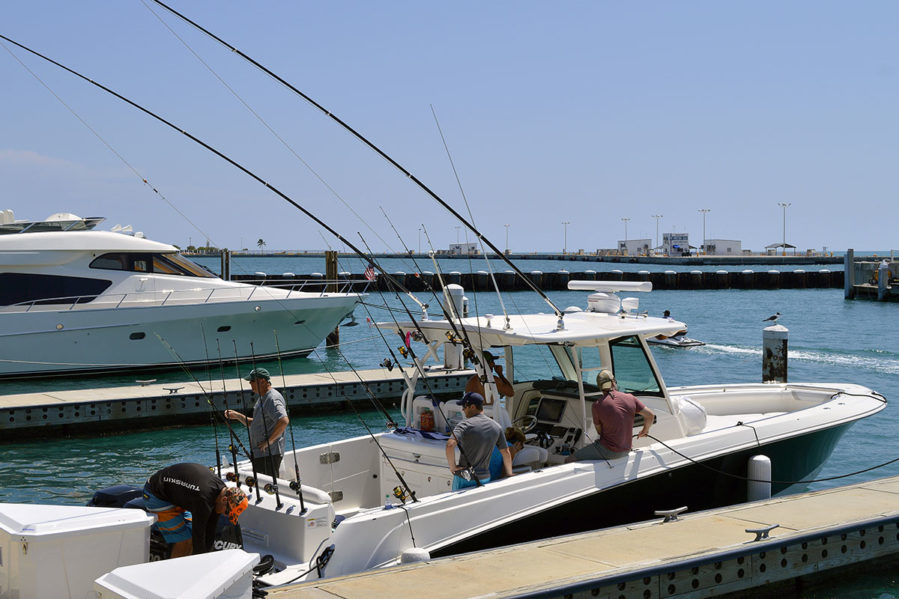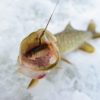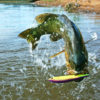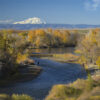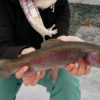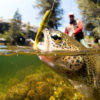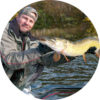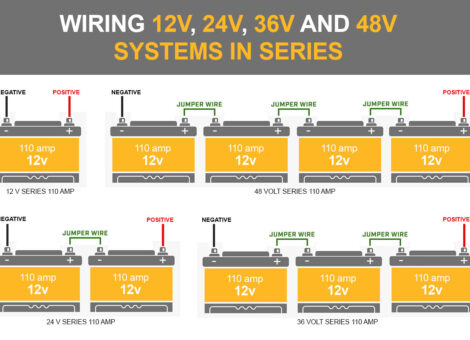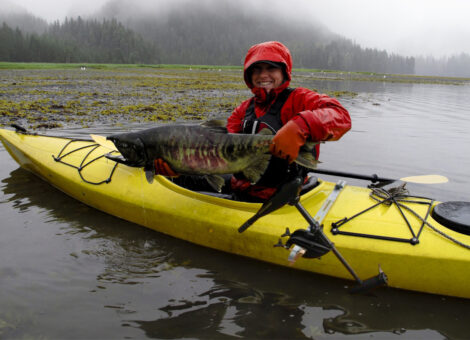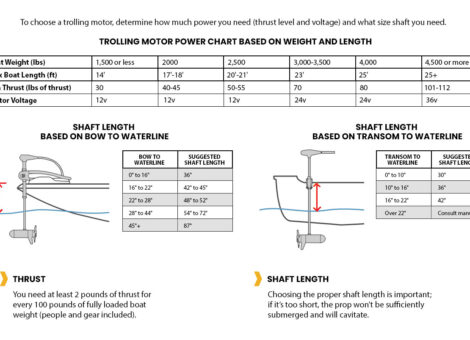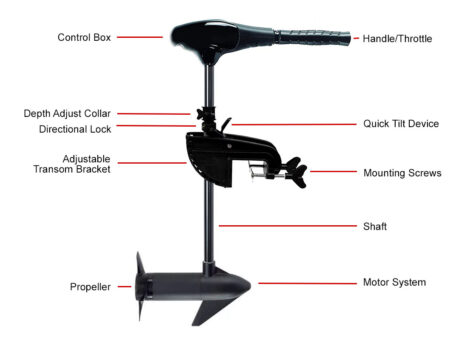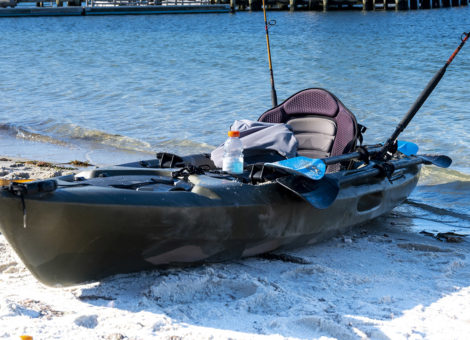If angling is becoming more than just a leisure passtime, it’s time to consider buying a fishing boat. A fishing boat, even a modest boat, will open the door to a variety of new and exciting fishing opportunities and experiences. However, before deciding what type of fishing boat to purchase there are several questions to consider. Will you be fishing alone or with a group? Will you be fishing the river, lake or ocean? How much can you afford? And I’m not just talking about price. Boats require maintenance — some more than others. Do you want a pricey Center Console Yacht with all the frills? Or is a relatively inexpensive, simple to maintain flat-bottomed Jon Boat more you’re style?
Below we’ll explore the different types of fishing boats along with the pros and cons of each. But before we get started, I want to invite you to do a little exercise. Clear your mind and envision your dream fishing experience. Is it inland or offshore? Are you with friends, family, close buddies… or are you by yourself enjoying some “me” time? Now envision the fishing boat that will help you achieve your dream fishing experience. How big will the boat need to be? What ammenities should it have? Take a few minutes and jot down it’s characteristics and qualities.
The above exercise is designed to accomplish two things. First, to help you identify what you really need in a fishing boat. Second, to help you identify what you really don’t need. There are a lot of nice fishing boats out there and it’s easy to get big eyes as you begin window shopping. Developing a solid needs list before you start will keep you grounded as you determine which fishing boat is right for you.
Fishing Boat Comparison Chart: Size, Range & Price
There are several considerations for selecting a fishing boat, but there are three selection criteria that are more important than the rest: size, usage and price. A fishing boat can have all the amenities in the world, but if it isn’t big enough for your fishing party, won’t get you where you need to be, or is outside of your price range, then you’re left with icing but no cake. Review the following comparison chart to determine which fishing boats meet your size, usage and price requirements.
| Boat Type | Size/Capacity* | Range/Usage | Price** |
|---|---|---|---|
| Air Boat | 12–18 ft; 1–5 | backwater, inshore | $15,000–$40,000+ |
| Bass Boat | 16–22 ft; 2–4 | lakes, inshore | $20,000–$45,000 |
| Bay Boat | 20–26 ft; 5 | backcountry, bays, inshore, nearshore | $10,000–$250,000+ |
| Cabin Cruiser | 25–45 ft; 4–10 | offshore, nearshore | $100,000–$500,000 |
| Canoe | 12–16 ft; 1–3 | inshore (protected waters) | $600–$1,500 |
| Center Console Boat | 15–40 ft; 4–10 | inshore, nearshore, offshore | $15,000–$1,000,000 |
| Convertible Boat | 30–60+ ft; 6+ | offshore (more than 40 miles) | $15,000–$6,000,000 |
| Cabin Cuddy Boat | 20–30 ft; 4–7 | nearshore, offshore | $10,000–$500,000 |
| Deck Boat | 15–25 ft; 4–14 | rivers, lakes, inshore | $15,000–$100,000 |
| Drift Boat | 12–21 ft; 1–4 | river | $3,000–$6,000 |
| Dual-Console Boat | 16–40 ft; 4–6 | inshore, offshore, bays | $10,000–$700,000 |
| Express Cruiser | 25–50 ft; 6–22 | offshore, nearshore | $12,000–$2,500,000 |
| Flats Skiff | 15–20 ft; 3 | inshore, flats, backcountry; shallow waters | $8,000–$140,000 |
| Flybridge Sportfishing Boat | 30–100 ft; 6+ | offshore (more than 40 miles) | $16,000–$6,000,000 |
| Inflatable River Raft | 15–25 ft; 6–7 | rivers | $1,000–$5,000 |
| Rigid Inflatable Boat (i.e. Zodiac) | 8–24 ft; 2–6 | inshore (protected waters) | $500–$40,000 |
| Jon Boat | 8–14 ft; 1–2 | flats, backcountry, inshore, nearshore | $500–$2,000 |
| Kayak | 20–35 ft; 4–7 | nearshore, offshore | $20,000–$1,000,000+ |
| Pilothouse | 18–30 ft; 6+ | lakes, inshore, nearshore | $15,000–$150,000 |
| Pontoon Boat | 25–50 ft; 6–30 | nearshore, offshore | $30,000–$6,000,000+ |
| Power Catamaran | 8–30 ft; 2–20+ | rivers, inshore, nearshore, offshore | $2,500–$350,000+ |
| Runabout | 14–25 ft; 4–6 | inshore | $5,000–$100,000+ |
| Walkaround Boat | 20–30 ft; 4–7 | nearshore, offshore, bays, lakes | $9,000–$1,000,000+ |
Air Boat
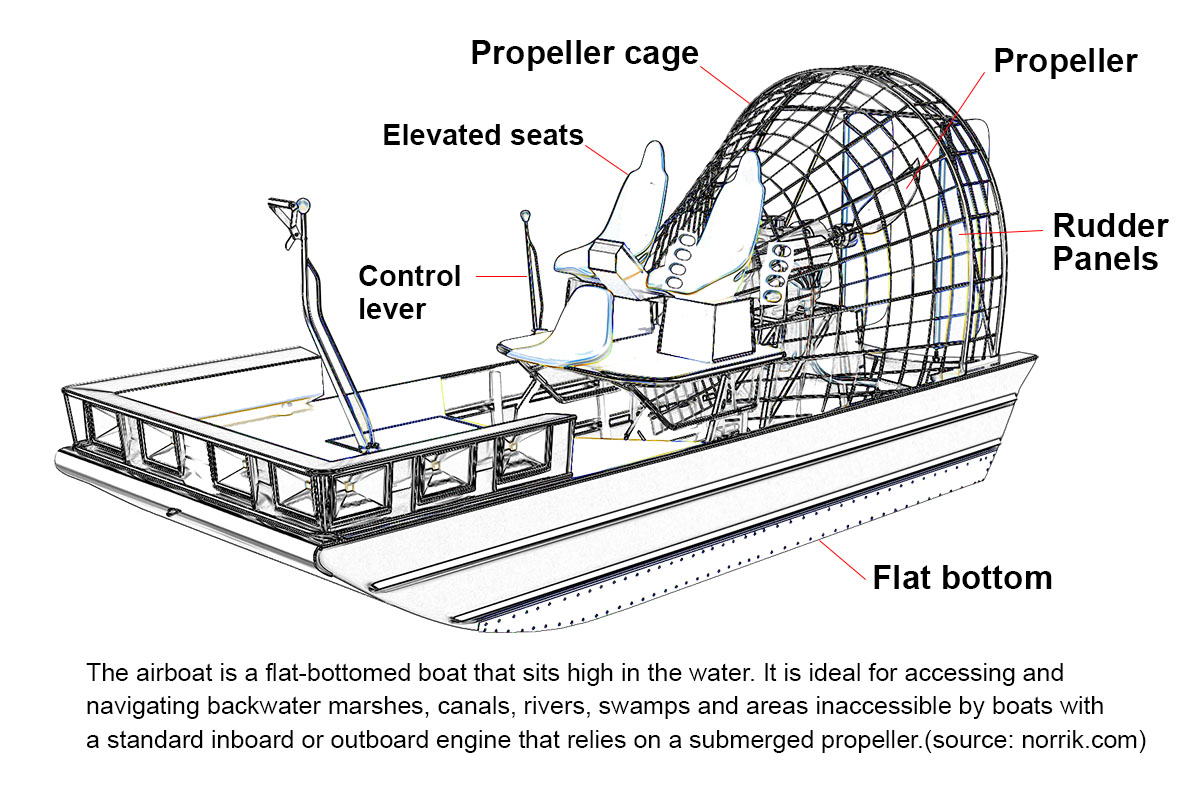
The airboat is a flat-bottomed boat propelled by a large aircraft-type propeller located at the rear of the boat. The propeller is powered by either an aircraft or automotive engine. The airboat is most popular in the deep south where it is commoning used to access marshy grasslands and shallow swamps that are inaccessible using traditional fishing boats. Due to its unique application and design, the airboat is often referred to as a planeboat or swamp boat.
An airboat is ideal for accessing shallow waters, including canals, rivers, marshes, lakes and frozen lakes, where underwater debree and vegetation prohibit the use of a traditional boat prop or self propelled watercraft (kayaks, canoes, etc.) are slow moving. An average used airboat will cost you between about $10,000 to $30,000, but new models with all the “fixings” can run up to $400,000.
Length: 12–18 ft
Capacity: 5
Range and usage: backwater, inshore, swamps, shallow wetlands
Price: $10,000–$30,000+
Pros:
- Great for accessing shallow water
- Access fishing areas other boats can’t
- Provide passengers a better view of surroundings
Cons:
- Not ideal for deep or rough water
- Are weight sensitive
- Can sink if not operated correctly
- Loud and expensive to operate
- Bumpy ride
Bass Boat
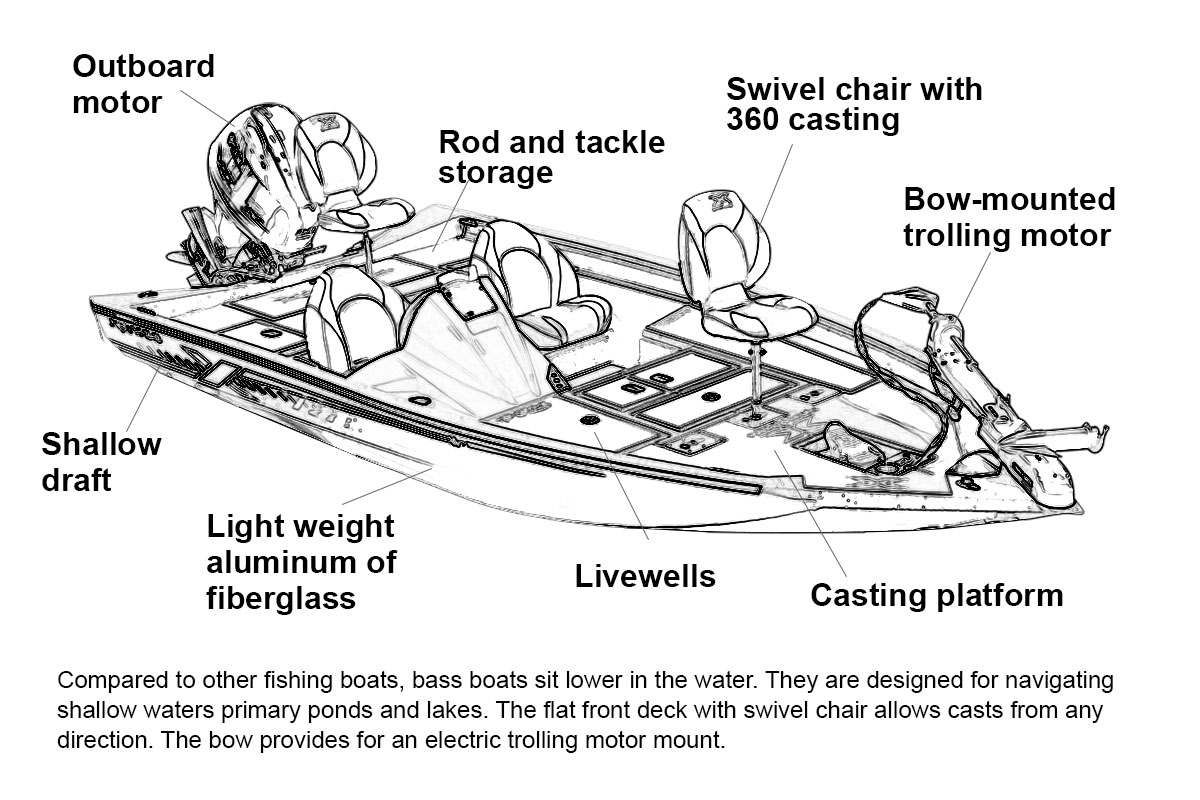
Bass boats are an ideal motorboat for freshwater fishing. They can be used to target a variety of fish species but are a favorite boat amoung bass anglers. Compared to other fishing boats, such as a Center Console or Cabin Cubby, the Bass Boat sits lower in the water. Bass boats are designed for fishing in shallow water. One of the unique features of a bass boat is the flat front deck with swivel chair that allows the angler to cast in any direction from one location.
Most bass boats come with an outboard motor and trolling motor. The outboard motor gets you to your fishing location fairly quickly. Once you’ve found your fishing location the trolling motor provides the mobility to slowly fish an entire area. An average bass boat will run you betweeen $20,000 and $45,000, but that’s not to say you can’t find a used bass boat in decent condition for less. Many bass boats come with a lot of high-tech fishing gear and navigation which can add substantially to the price. Unlike many fishing boats, most bass boats come with a live bait tank.
Length: 16–22 ft
Capacity: 2–4
Range and usage: lakes, inshore
Price: $20,000–$45,000
Amenties: navigational equipment, livewells, trolling motor, anchor system, fishing seats
Pros:
- Ultimate fishing boat for freshwater
- Outboard motor for power and speed
- Very comfortable seating
Cons:
- Limited occupancy
- For their size, much pricier than other fishing boats
- Limited protection from the elements
Bay Boat
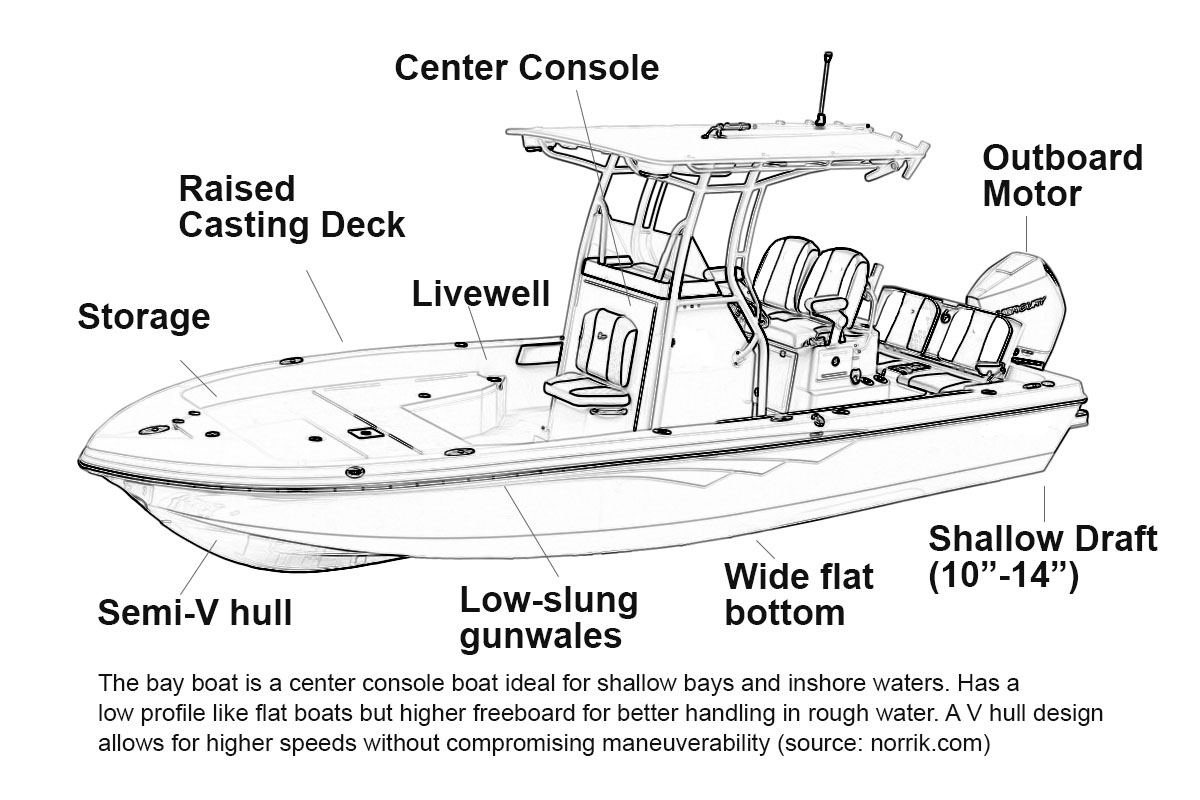
The bay boat is a center console fishing boat that was originally designed to fish bays and shallower inshore areas. Like flats boat, the bay boat maintains a low profile but its higher freeboard allows the bay boat to handle better in rougher water. The bay boat can withstand waves and depth changes while providing a comfortable fishing experience for anglers.
A powerful single outboard motor complimented with a modified V hull design allows the bay boat to handle high-speeds while still maneuvering the shallows. There’s no doubt the bay boat is an ideal vessel for fishing inshore, but it doesn’t offer as much room as larger fishing boats. Including the captain, the maximum occupancy of a bay boat is five. You can pick up a used, older model bay boat for about $10,000. Newer models can easily reach over $200,000.
Length: 20–26 ft
Capacity: 5
Range and usage: backcountry, bays, inshore, nearshore
Price: $10,000–$250,000+
Amenties: livewells, extensive storage, fix boxes
Pros:
- Easy maneuverability in inshore shallows
- Handle rough water relatively well
- Easy fishing boat for beginners
- Good storage, seating and high freeboard
Cons:
- Not great for offshore fishing
- Must be in a least 10′-12′ of water
- Not as good as a flats skill for shallow water
Cabin Cruiser
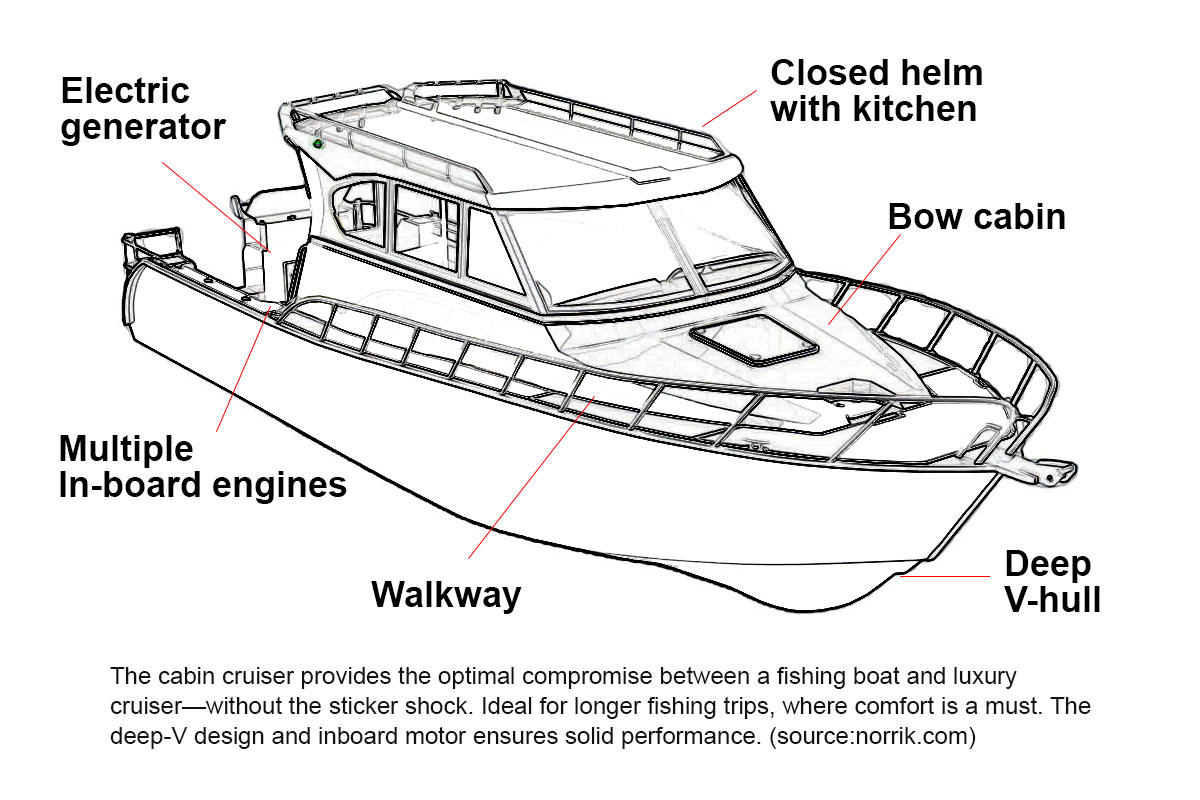
Cabin Cruisers are designed to allow anglers to travel in style. I have found that fishing from a cabin cruisers it like going camping in a class A motorhome. You get the full fishing experience, but it’s only a few steps back to comfort. The hull of a cruiser is a deep-V design and typically made out of fiberglass. With dual inboard motors, a cabin cruiser really has some pickup and go.
Used cabin cruisers are going anywhere from $8,000 to $30,000. Newer models start at about $30,000 and can go into the millions depending on size and amenties. But the majority of higherend cruisers will be just over $100,000. With a cruiser you get the comforts of a yacht in small package, with a smaller price tag.
Length: 25–45 ft
Capacity: 4–10
Range and usage: offshore, nearshore
Price: $100,000–$500,000
Amenities: all creature comforts, swim platforms, full enclosure
Pros:
- Ideal for nearshore and offshore fishing
- Creature comforts (beds, dining, toilets, etc.)
- Comfortable ride (even in rough waters)
- Allow for on-the-water travel
Cons:
- Shortage of headroom for tall folks
- Can get stuff w/o good a/c
- High fuel consumption
- Lack of foredeck access
Canoe
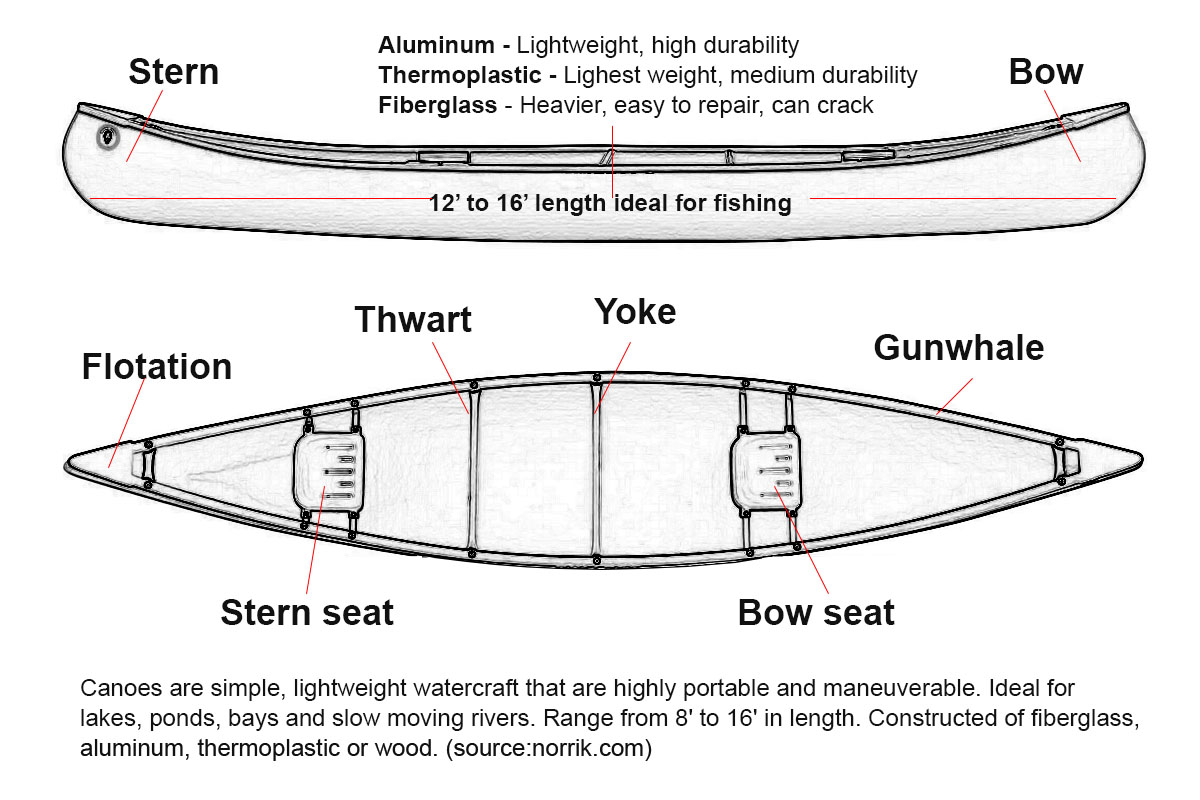
Canoes are simple, lightweight watercraft. They are an excellent option for fishing ponds but can also be used on rivers and lakes. Canoes run anywhere from 8 to 16 feet in length, but shorter canoes around 12′ to 16′ are–in my opion–the ideal length for fishing. Shorter canoes are also best if you plan on fishing the river (although rapids should be avoided.) A good mid-size canoe can be equiped with a small trolling to keep you from constantly rowing.
Canoes are constructed out of fiberglass, aluminum or wood–with wood canoes being the more expensive option. A full-length, hand-crafted wood canoe can run on the upwards of $3,000 or more, but you can pick up a cheap fiberglass canoe that will get the job done for just over $200. For a good fishing canoe, I’d budget for about $600 to $1,500.
Length: 12–16 ft; 1–3
Capacity:
Range and usage: inshore (protected waters)
Price: $600–$1,500
Amenties: What amenties? Two paddles.
Pros:
- Easy to transport
- Relatively inexpensive
- More carrying capacity than a kayak
Cons:
- Unstable (don’t stand up!)
- Limited capacity
- Difficult to anchor
Center Console Boat
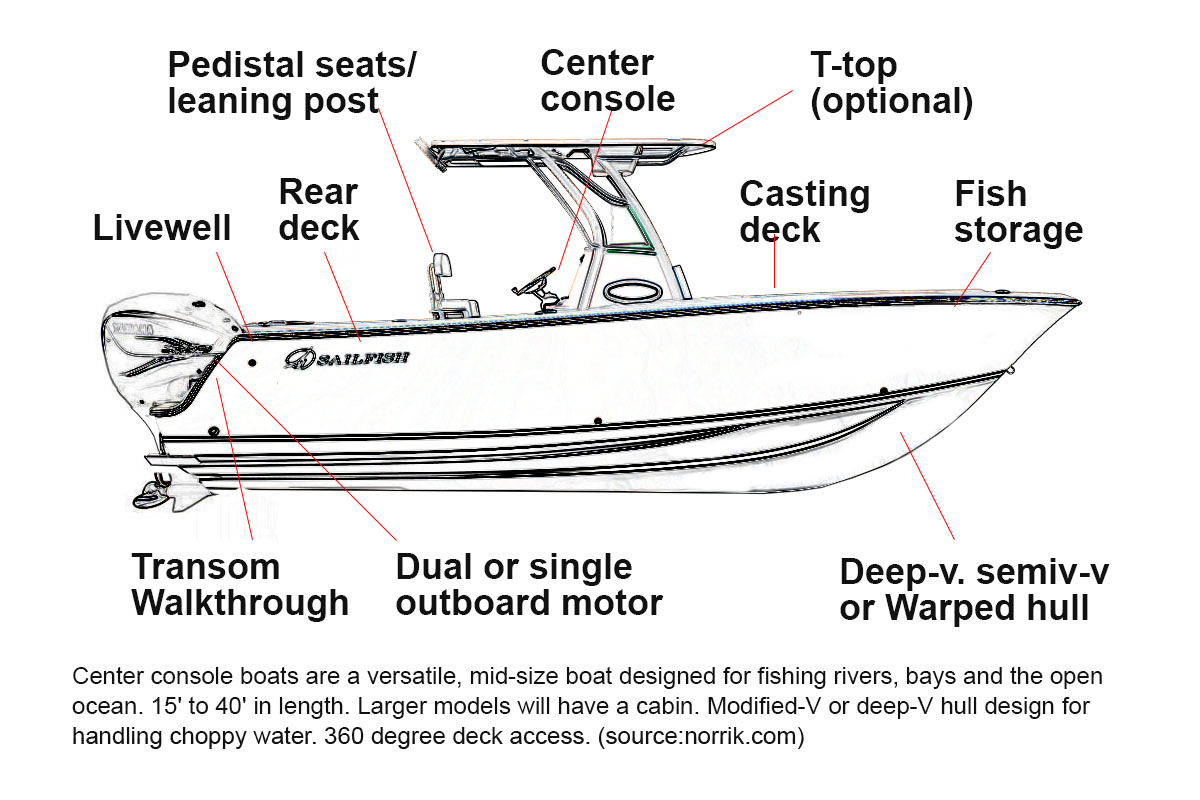
Center console boats are one of the most versatile of fishing boats–and quite possibly one of the best mid-size motorboats for angling. They are great for river fishing, bay fishing, or fishing the open ocean. Center consoles range in length from 15′ to 40’+, but most will be around 20+ feet. Smaller center consoles are comfortable and maneuverable, but they often lack a cabin. If you want a cabin for overnight capability, you’ll need to purchase a larger model.
The most common hull design for the center console boat is either deep-V or modified-V. Like most fishing boats the center console is fabricated using fiberglass. The centerconsole can come with a single outboard motor, multiple outboards (up to 4) or stern drives. An average size center console will hold about 6 passengers but larger models can easily accomodate 20+ occupants.
Like most fishing boats, center consoles can be purchased at a variety of price points. You can get into an older model center console for as little as $10,000 or spend up to $1,000,000 on a larger newer model
Length: 15–40 ft; 4–10
Capacity: 4–10+
Range and usage: inshore, nearshore, offshore
Price: $15,000–$1,000,000
Amenities: livewells, fish boxes, outriggers, T-tops, storage, trolling motor (optional), toilet (optional), cabin (optional), outriggers and downriggers (optional)
Pros:
- 360 degree fishability
- Less expensive to run than larger offshore boats
- Can fish inshore or offshore
Cons:
- Fewer creature comforts than other offshore boats
- Limited shade and weather protection
- No cabin
Convertible Boat
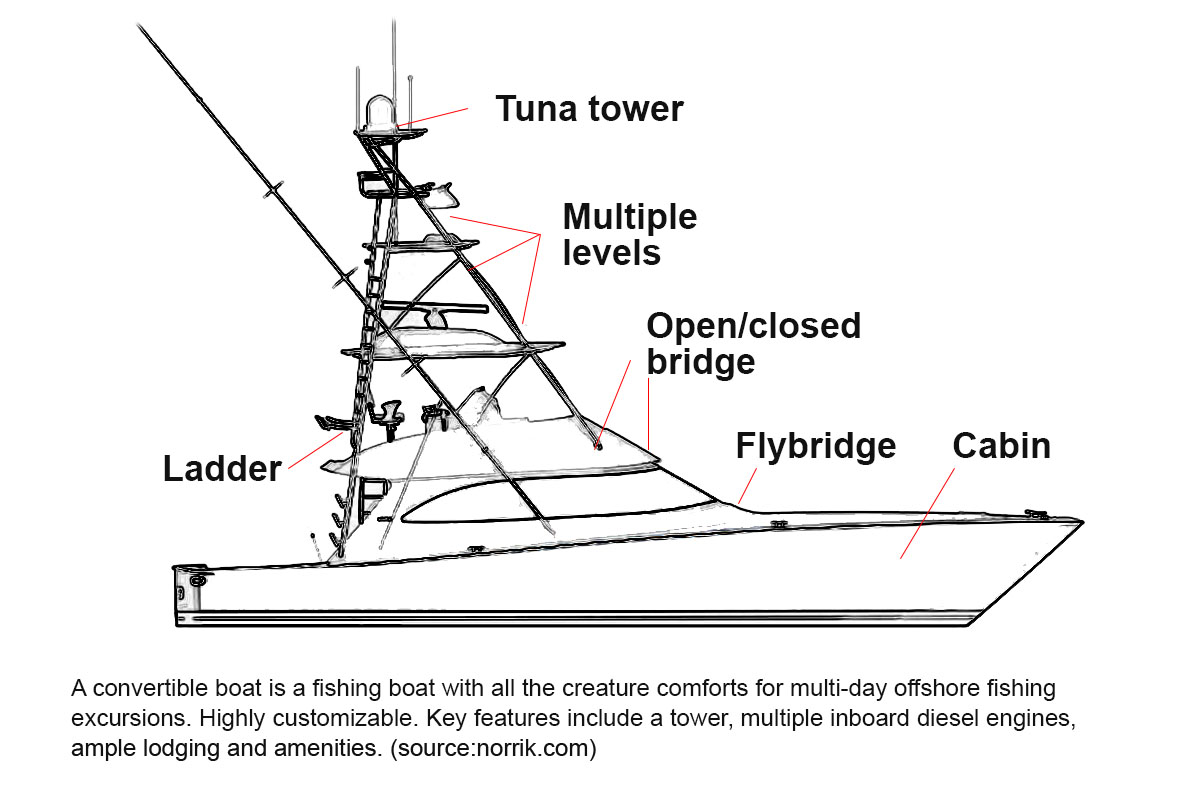
When it comes to fishing offshore in the big seas, it doesn’t get any better than the Convertible boat. I dare say convertible boats (aka convertible sportfishing boats) have it all. A tower, powerful inboard diesel engines, creature comforts, comfortable lodging for multi-day fishing trips, and ammenties galore! If you have the cash, convertible can be customized to meet your every whim. Convertible boats are ideal for targeting large deep-sea sportfish species such as sailfish, sworfish and marlin.
Convertible boats are typically between 30 and 60 feet in length, but I’ve seen even longer. For as big as they are they have some get up and go. With multiple inboard diesel engines, larger convertible boats can accelerate to 30mph no problem. You can get into an older, used convertible boat for around $15,000 but at this level you’re really not going to experience what convertible boats are all about. You average, higher-end convertible fishing boat is going to cost you $90,000 thereabouts and can run into the upper millions.
Length: 30–60+ ft
Capacity: 6+
Range and usage: offshore, long-range angling
Price: $15,000–$6,000,000
Amenities: navigational equipment; tower; berths, galley, and head; outriggers; flybridge (typically); livewell tank; rod holder; safety equipment
Pros:
- Supports multi-day fishing trips
- Very comfortable
- Engine room is away from helm and minimizes vibration
Cons:
- Pricey! They are expensive to purchase and maintain.
- Expensive to maintain
Cabin Cuddy Boat
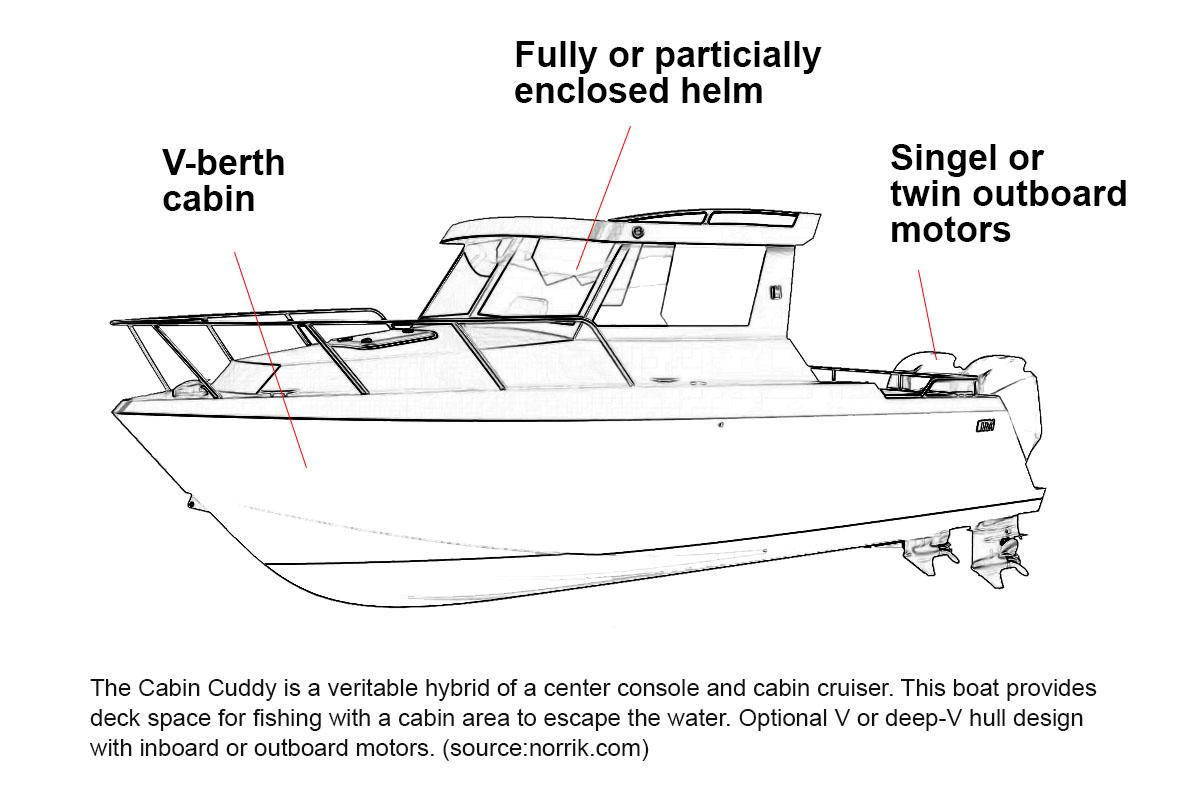
Envision a center console boat with a cabin and deck. In my opinion, that’s the best way to think about a cuddy cabin. They’re very similar to center console boats with the added benefit of a cabin area to get you out of the elements when weather gets rough. Cuddy cabins also provide deck space that can be used for fishing. These boats are ideal for families with kids and when you want a quality fishing boat at a reasonable price.
Most cuddy cabins are between about 20 and 30 feet in length. You can find smaller models, but I recommend getting at least a 20 footer if you plan on taking extended fishing trips. Cuddys can have either inboard or outboard motors and are built a V or deep-V hull. A good cuddy cabin can be picked for anywhere fro $10,000 to $500,000, but your average cuddy in good condition is going to to cost between $20,000 to $100,000 depending on size and amenties.
Length: 20–30 ft
Capacity: 4–7
Range and usage: nearshore, offshore
Price: $10,000–$500,000
Amenities: navigational equipment, rod holders, livewell, cabin, kitchen (optional), outriggers, downriggers (optional), fighting chair
Pros:
- Comfortable cabin
- High value cost benefit
- More creature comforts than a center console
Cons:
- Limited fishing from sides and deck
- Can’t easily move all the way around the boat
Deck Boat
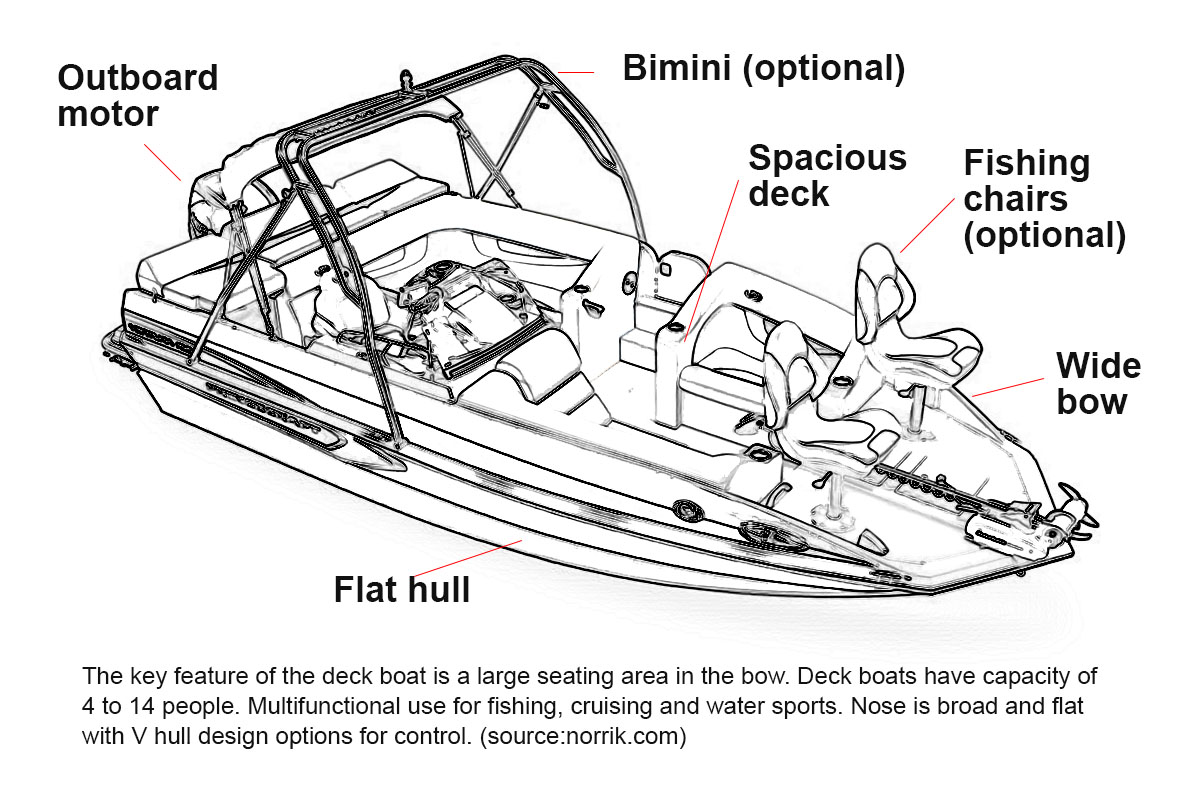
Deck boats provide a large seating area in the bow of the boat that can be used for cruising and fishing. These boats are multifunction and are ideal for everything from fishing to skiing, wakeboarding and cruising. When you want it all, the deck boat is great choice. Compared to other boats that traditionally have a V-shaped nose, the nose of the deck boat is broad and flat. The boat does have a modified V, V or deep V hull design that allows for optimal control and maneuverability. The deck boat is at home in both freshwater and saltwater environments. If you’re going to use your deck boat in the ocean, I recommend purchasing one with deep V hull design.
Deck boats are about 15 to 25 feet in length. For each foot, the deck boat provides more sitting and storage space than other comparable fishing boats of the same length. If you want to buy a deck boat, rices for an older, used model are going to start around $10,000 and run up to about $25,000. Newer, basic models will start at about $15,000 and can reach over $100,000 when fully decked out.
Length: 15–25 ft
Capacity: 4–14
Range and usage: rivers, lakes, inshore
Price: $15,000–$100,000
Amenities: live wells, rod holders, navigation electronics, tackle storage, ski storage, (and more)
Pros:
- Versatile/multi-use
- Lots of sitting space
- A lot of space for the length
Cons:
- Not the ideal boat for small bodies of water
- They need deeper water
- Doesn’t provide a cabin for shelter
Drift Boat
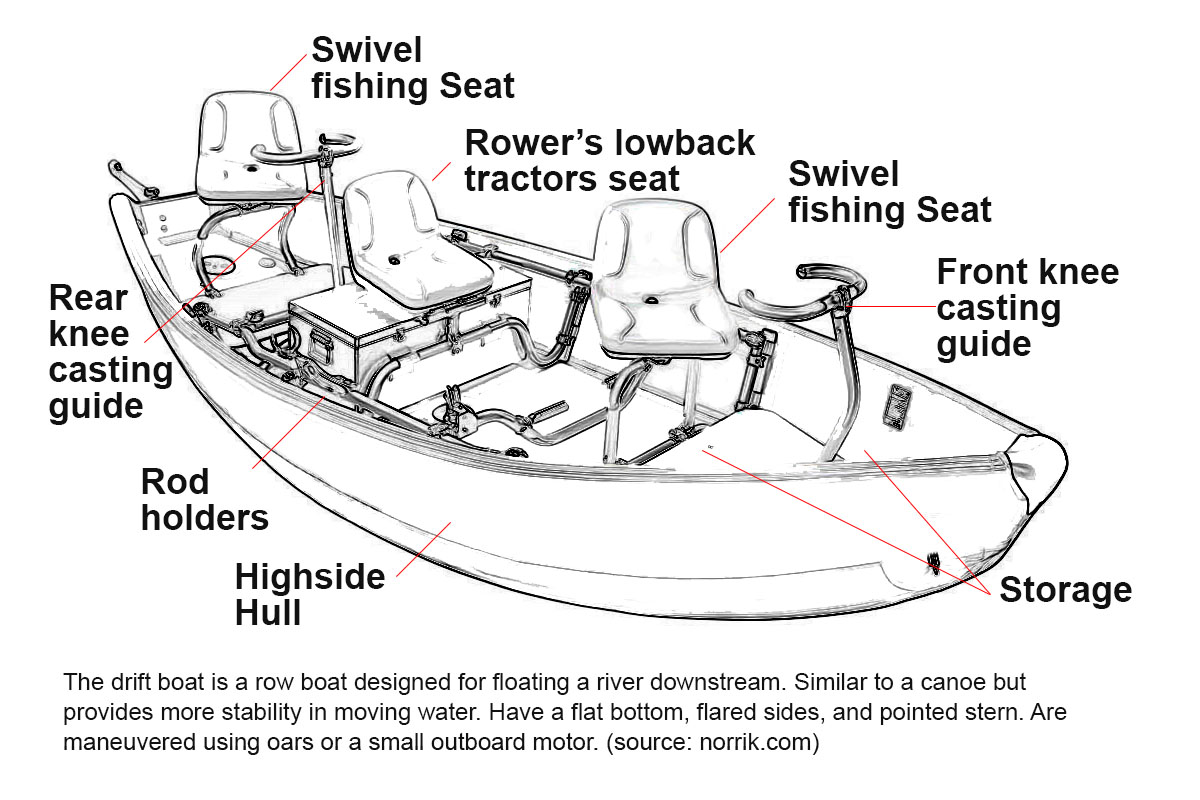
The drift boat is a type of row boat that is designed primarily for fishing rivers. It allows an angler to float a river downstream while fishing the flats, current and eddies. The drift boat is similar to a canoe but a bit larger and provides more stability in moving water. On moving water a drift boat typically requires one person to man the oars. Most drift boats are sell propelled, but they may be outfitted with a small outboard motor.
Drift boats range between 12 and 21 feet in length, have a wide, flat bottom, flared sides, and pointed stern. The most popular length for drift boats for fishing are between 14 and 16 feet. Small drift boats (12′-16′) will typically have a 48″ bottom. Larger drift boats (16′-20′) usually have a 48″ bottom. Obviously, larger drift boats will offer more space and occupancy.
Length: 12–21 ft
Capacity: 1–4
Range and usage: river, lakes
Price: $3,000–$6,000
Amenities: oars, outboard motor (optional)
Pros:
- Designed for fishing rivers
- Relatively inexpensive
- Easy to maintain
Cons:
- Not as stable as other fishing boats
- When river fishing, must be manned by more than one person
- Limited occupancy
Dual-Console Boat
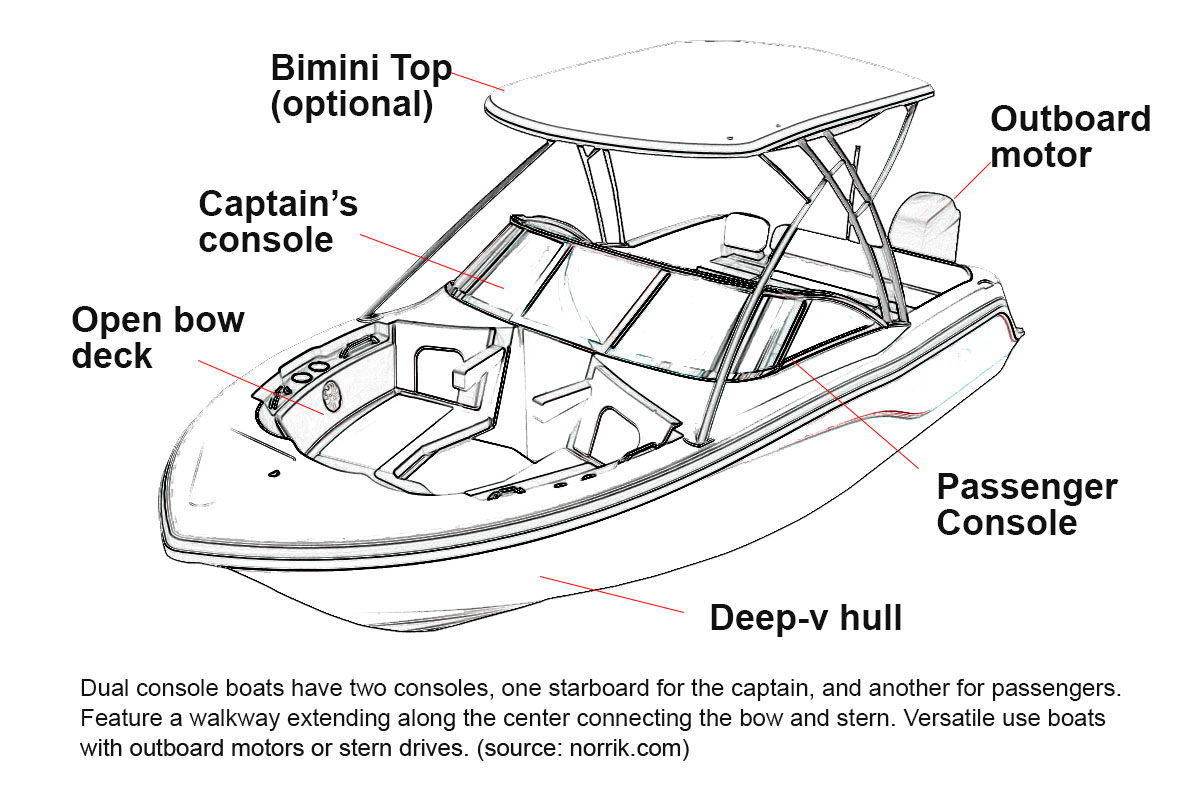
The dual-console boat, as its name suggests, has two consoles. In fact, its dual console is the most distinguishing feature of the dual-console boat. There is one console for the captain on the starboard side of the boat (where the helm is located), and another on the port side where passengers sit. Most dual-console boats have a wide walkway extending along center connecting the bow and stern. Larger model may be outfitted with a cabin. Dual-console boats typically have a wider range of uses than comparable fishing boats and are somewhat similar to bowriders and fish-and-ski boats.
Dual-console boats can be fitted with single or twin outboard motors or stern drives. They can be used to fish in various freshwater and saltwater environments. You can get into a basic, older model dual-console for about $10,000. Newer dual-console models, with all the amenities can top $700,000.
Length: 16–40 ft
Capacity: 4–6
Range and usage: inshore, offshore, bays
Price: $10,000–$700,000
Amenities: ski storage, tackle storage, navigation electronics, galley, berths
Pros:
- Can handle harsher conditions than bowriders or runabout boats
- Very versatile. Used for fishing and water sports
- Provide more protection of the elements than the center console design
Cons:
- Doesn’t provide 360 degree fishing access like a center console boat
- Limited deck space for fishing compared to a center console layout
Express Cruiser
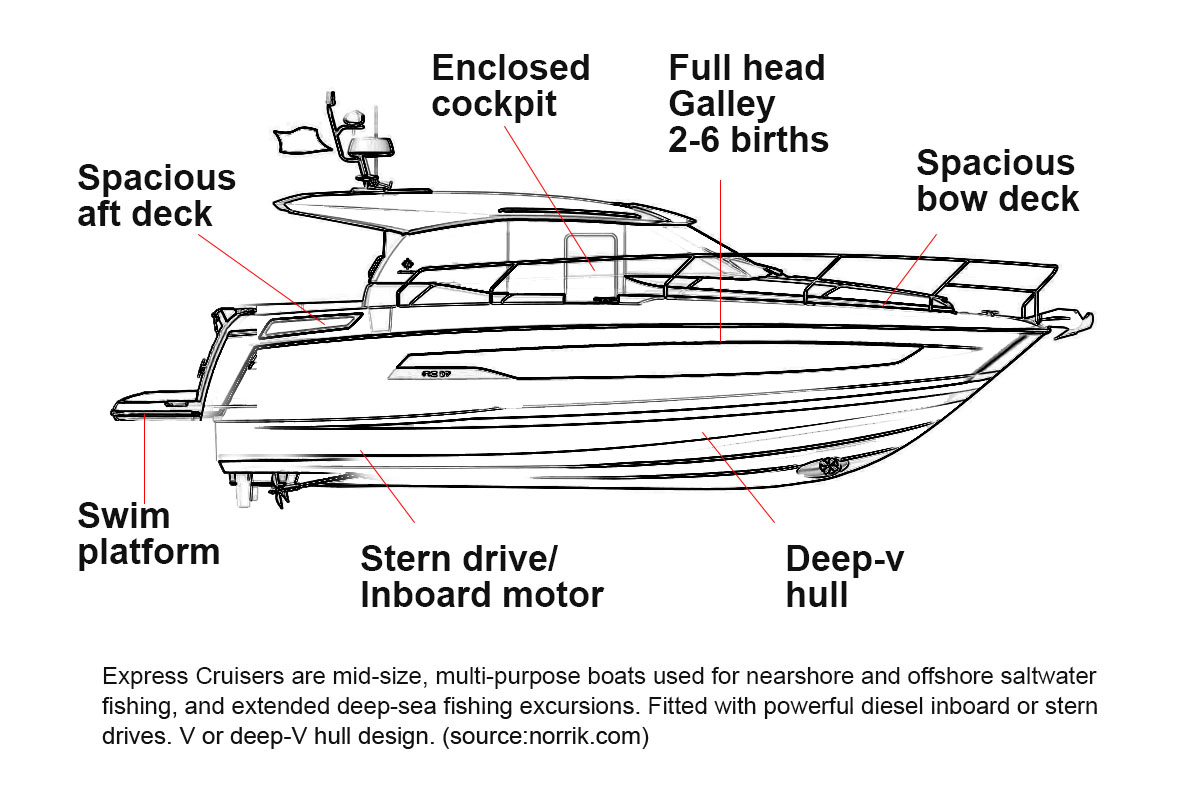
Express Cruisers are mid-sized, multi-purpose boats used for fishing nearshore and offshore saltwater environments. They can also be used for fishing larger lakes but most people purchase an express cruiser for ocean use. The larger models (25′ to 50′) are ideal for deep-sea fishing excursions.
Express cruisers typically come with powerful inboard (diesel) motors or stern drives, but some models are equiped with outboard motors. Larger model cruisers and have motors generating a whopping 3,100 horsepower. Smaller models may generate as low as 225 horse power. The hull is a V or deep-V design constructed of fiberglass or wood designed to stand up to the harsh water conditions of the open ocean.
Used, older model cruisers can be picked up for almost nothing ($12,000). They’re are usually a lot for sale on the market. But just remember you get what you pay for. I’d prefer buying a little newer, higher quality boat than continue to dump money into it and be constantly concerned about its seaworthiness. The price for new model express cruisers can reach into the several millions of dollars, but you should be able to get your hands on a quality, well-maintained newer model express cruiser between $80,000 and $500,00.
Length: 25–50 ft
Capacity: 6–22
Range and usage: offshore, nearshore
Price: $12,000–$2,500,000
Amenities: Many creature comforts, but lack many fishing amenities
Pros:
- Great for deep-sea fishing
- More maneuverable than a convertible
- Powerful and fast
- Versatile. Can be used for cruising and water sports
Cons:
- Poor fuel economy, hence, a limited range
- Expensive for their size
- Limited deck and cabin space
- Limited area for fishing
Flats Skiff
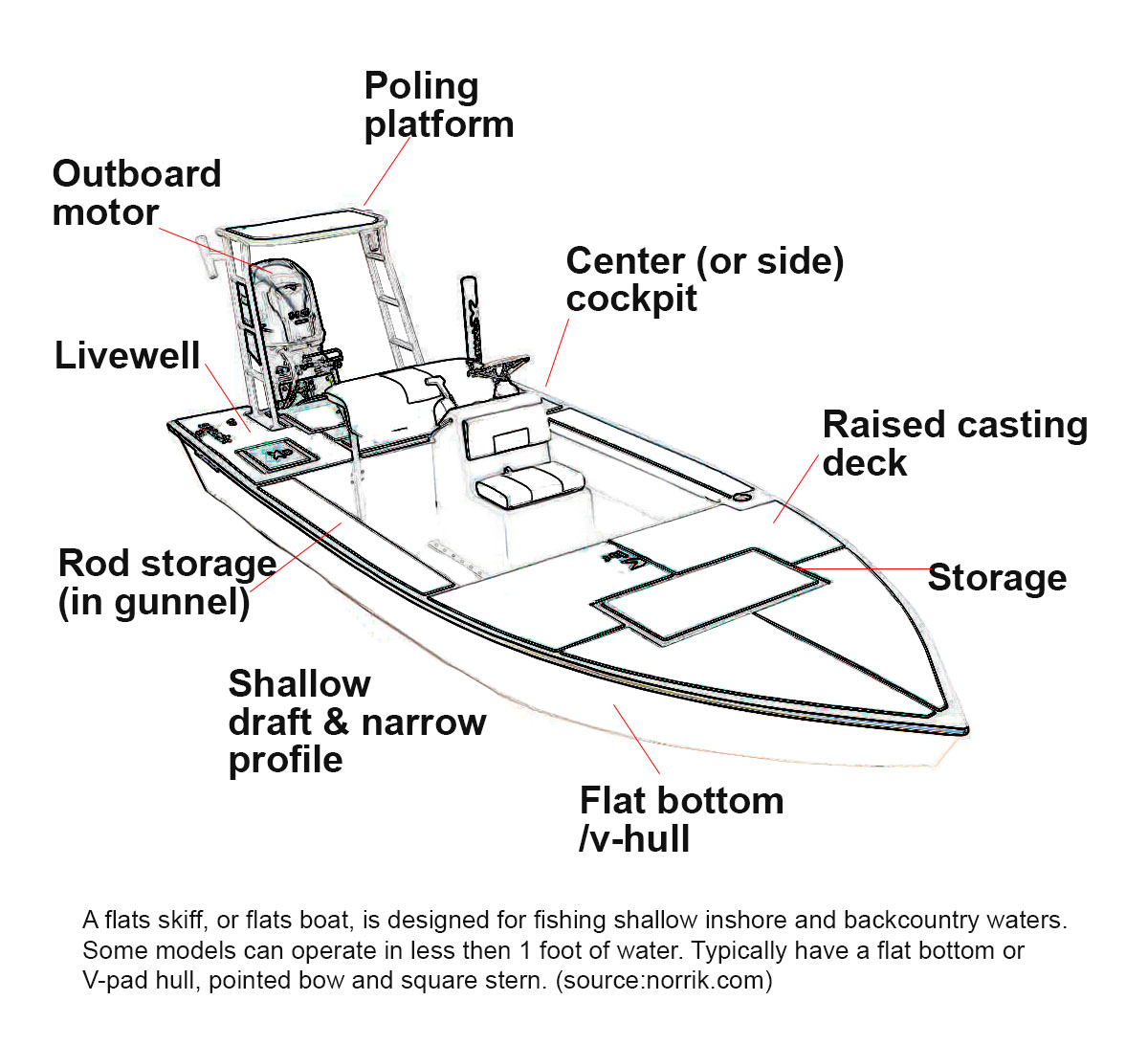
A flats skiff, also referred to as a “flats boat” or simply “skiff”, is an ideal boat choice for fishing shallow inshore and backcountry waters. The flats skiff is a particularly popular choice of boats for anglers fishing the shallow inshore waters of Southern Florida’s bays and marshes, or the flats in surrounding coastal states such as South Carolina. Several models of flat skiffs, such as the flats scooter, can operate in less than a foot of water. I love fishing coastal areas for bonefish, redfish and permitt from the forward casting platform of a skiff. Can’t beat the experience.
You can get into a flats skiff for an incredible $2,000. Can’t beat that. But this is going to a smaller, used, basic model, no frills skiff. New larger-model flats skiffs with basic amenities for fishing typically start around $5,000 and can run up to over $100,000.
Length: 15–20 ft
Capacity: 3
Range and usage: inshore, flats, backcountry, shallow water lakes and ponds
Amenities: standing platform over outboard engine, navigational equipment, live bait tank, outboard motor, trolling motor (optional), shallow water anchoring system, casting platform, rod holders (optional)
Price: $8,000–$140,000
Pros:
- Flatbottom of accessing shallows
- Versatile
- Relatively afforable
Cons:
- Don’t handle well on open water or in bad weather
- Little storage space
- Limited to shallow water excursions
Flybridge Sportfishing Boat
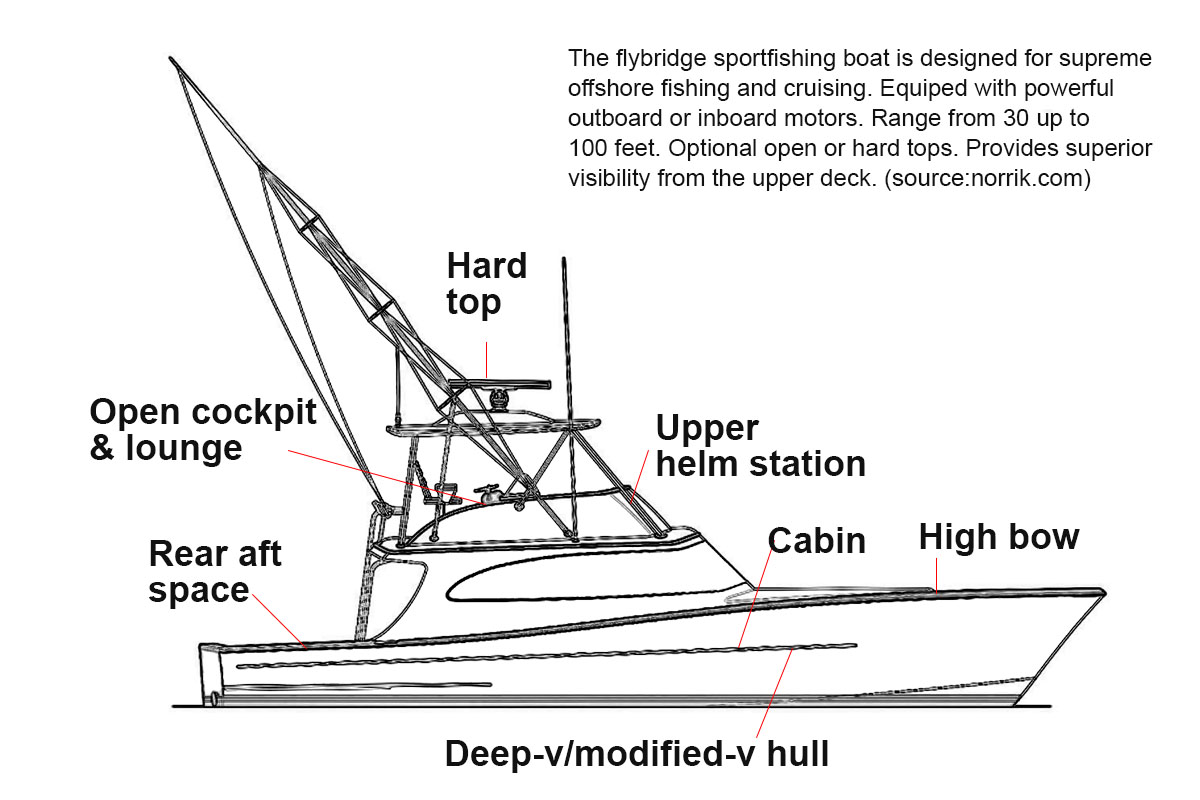
Flybridge sportfishing boats are designed for one purpose, to make locating and catching fish as easy and as enjoyable as possible. The flybridge sportfishing boat is just that–the supreme offshore sportfishing boat. These boats are typically equiped with powerful outboard or inboard motors that will get you to your desired offshore fishing spots quickly and in comfort.
But not all sportfishing boats are equal. As with most types of boats, there are various sportfishing boat sizes and models. Flybridge sportfishing boats are typically larger than most other types of fishing boats. Sportfishing boats range from 30 feet on the shorter end up to 100 feet for larger vessels. And their extra size doesn’t come without a price tag. You can get into smaller used sportfishing boat for around $10,000. But to get something a bit more reliable and newer, you’re looking at $100,000 to $200,000, if not more. High-end flybridge sportsfishing boats can go for more than six figures.
Due to their high price tag, these boats are often purchased by professional organizations for use as fishing charter boats.
Length: 30–100 ft
Capacity: 6+
Range and usage: offshore (more than 40 miles), saltwater only
Price: $16,000–$6,000,000
Amenities: berths, galley, plumbing (toilet), navigational system, rod holders, live bait tank, outriggers, downriggers, tuna/marlin tower, fighting chair
Pros:
- Designed for serious big game offshore fishing
- Can support multi-day fishing excursions
- Made for speed
- Comfortable living accomodations
Cons:
- They aint cheap!
- Less maneuverable than a comparable center console boat
Inflatable River Raft
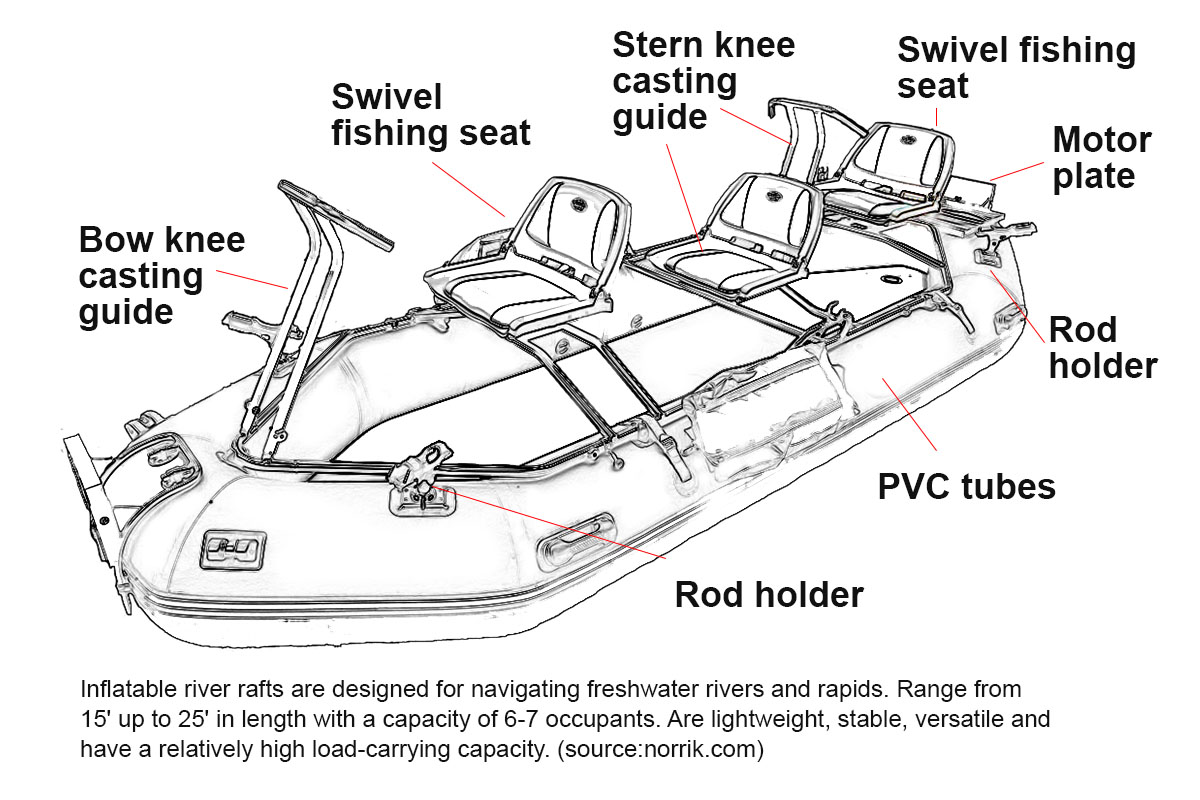
Inflatable boats are ideal for navigating the rapids on freshwater rivers home to some of the best fishing in North America. For rivers include the Green River, Selway River, Snake River, Salmon River, Chattooga River and Arkansas River (to name just a few), you can’t go wrong with a sturdy inflatable boat.
Inflatable boats and rafts designed for river usage, are usually between 15′ on the small end and 25′ on the upper end.
Length: 15–25 ft
Capacity: 6–7
Range and usage: rivers
Price: $1000–$5,000
Amenties: oars, seats, rod holders
Pros:
- Very portable
- Safe and navigable in river rapids
- Relatively inexpensive
Cons:
- Don’t provide much storage
- No protection from the elements
- Can be a rough ride at times
Rigid Inflatable Boat (i.e. Zodiac)
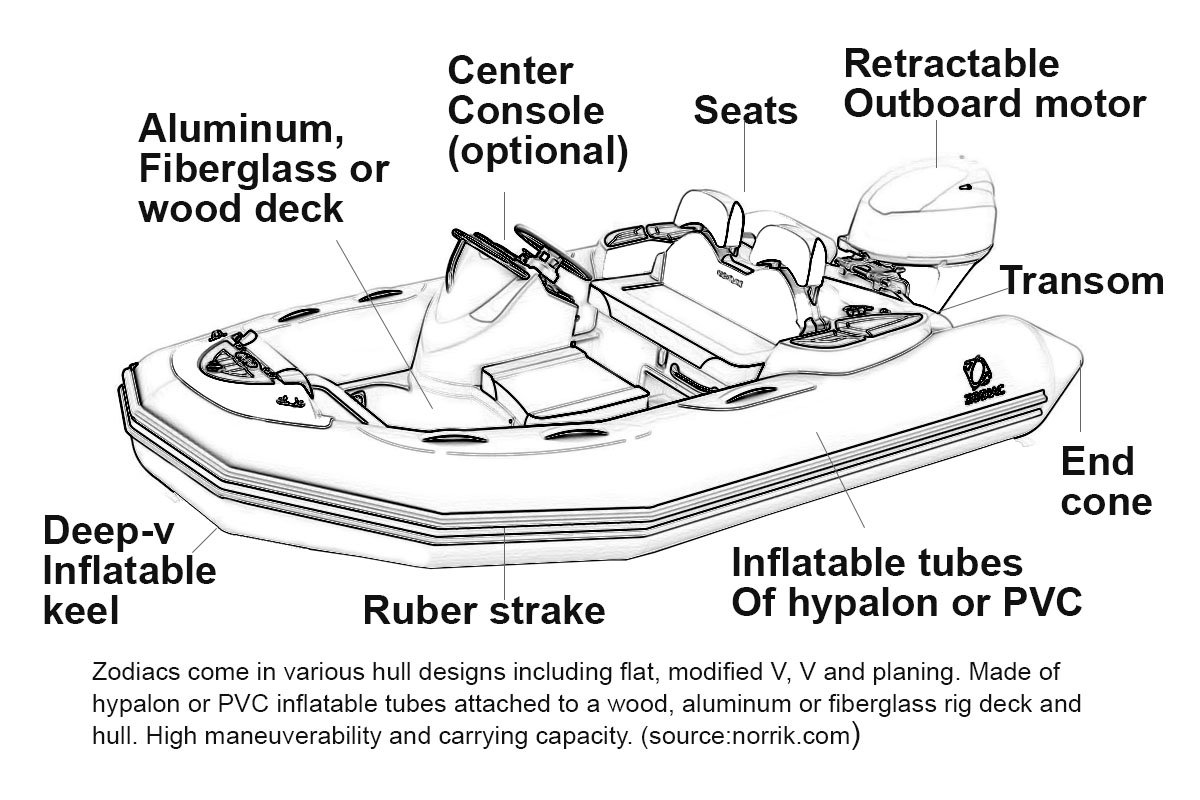
We’ve come to my favorite fishing boat of them all, Rigid Inflatable Boats–better known as Zodiacs. I had a Zodiac for nearly 10 years that I used for crabbing and fishing the coastal waters off Bodega Bay in Northern California. Can’t say I’ve ever had more fun with a boat than I did my Zodiac. But they ain’t all sunshine and roses. Let’s explore.
Zodiacs are small inflatable boats that serve well for fishing. When most people think of zodiacs they envision the small inflatable boat used to transport passengers and cargo ashore from a larger sportfishing boat or cruiser anchored at bay. And they do serve this purpose. But zodiacs are so much more.
Zodiacs come in an array of sizes and are very customizable. They can be anywhere from 8′ to 30′ in length and come in various hull designs including flat, modified V, V, and planing. Zodiacs are made of inflatable tubes attached to a rig deck and hull fabricated of wood, aluminum or fiberglass. Due to their modular design, they can incorporate various add-ons and amenities including an angler’s seat, console or even a T-top to provide protection. Zodiacs are highly maneuverable and can be used in a variaty of freshwater and saltwater fishing environments.
For a good fishing Zodiac you’re realistically going to pay a minimum of $2,500 to $15,000, depending on size and condition. You want to make sure the rigid inflatable boat you purchase is in good condition. Purchase a used Zodiac with tears, seams coming apart, or other issues, and you’re going to have a nightmare on your hands. Also, don’t purchase a Zodiac that has more than 5-7 years of use. Your average Zodiac is only going to last a max of 15 years.
Length: 8–30 ft
Capacity: 2–20+
Range and usage: rivers, inshore, nearshore, offshore, lakes
Price: $2,500–$100,000+
Amenties: oars, seats, console, t-top, storage, outboard motor (single or multiple)
Pros:
- Highly maneuverable
- Easy to transport and set up
- Stable on the water
- Durable
Cons:
- Low life expectancy
- Challenging to repair
- Can puncture; Seams fail
Jon Boat
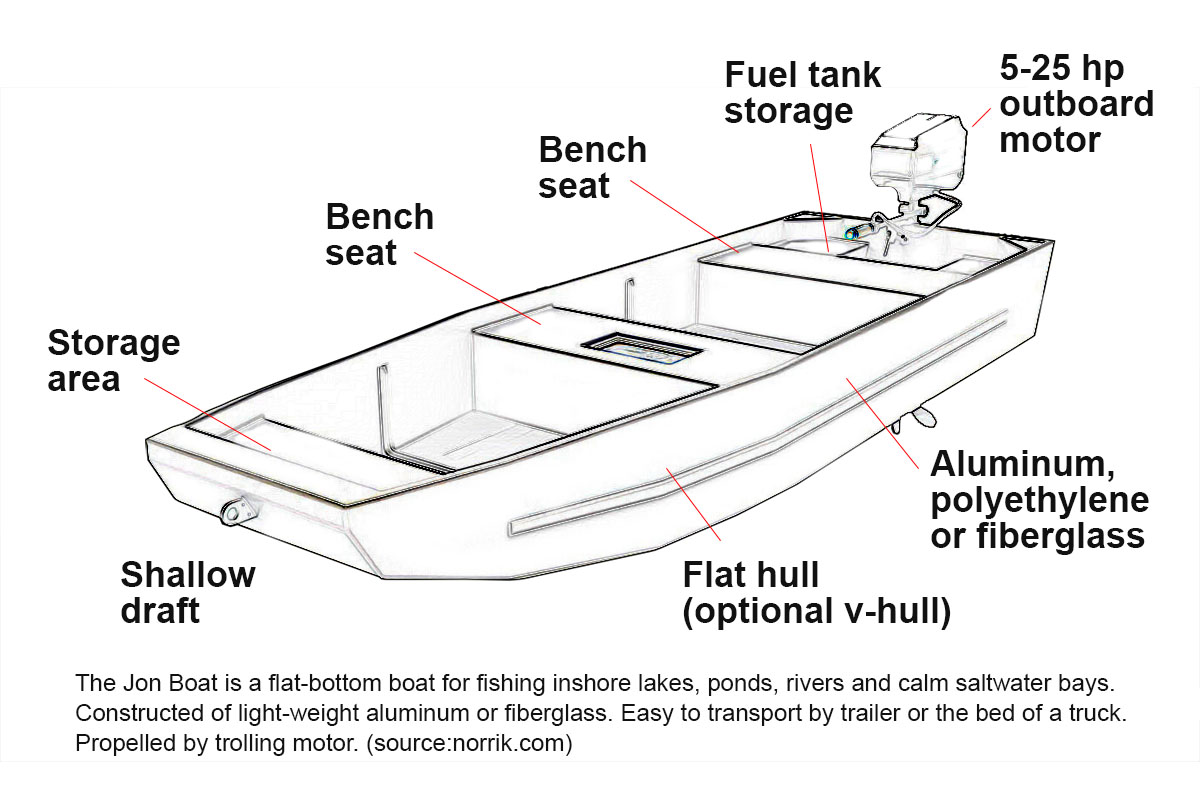
The Jon boat is a popular, no-frills flat-bottom fishing boat that is easy to transport and maneuver in the water. Jon boats are usually constructed of aluminum or fiber glass and weigh next to nothing when compared with other fishing boats of their size. They can be transported on a trailer or just as easily in the bet of a truck. They’re designed for fishing inshore lakes, pond and rivers. They can also be used on calm bays. They are propelled using oars or a small outboard or trolling motor.
Length: 8–24 ft
Capacity: 2–6
Range and usage: inshore (protected waters), lakes, ponds, rivers
Price: $500–$40,000
Amenities: rod holders, swivel chair, storage
Pros:
- Inexpensive to buy and maintain
- Easy to transport
- Easy to use (and stable)
Cons:
- Limited to inshore fishing
- Simple, few amenties
- No protection from the elements
Kayak
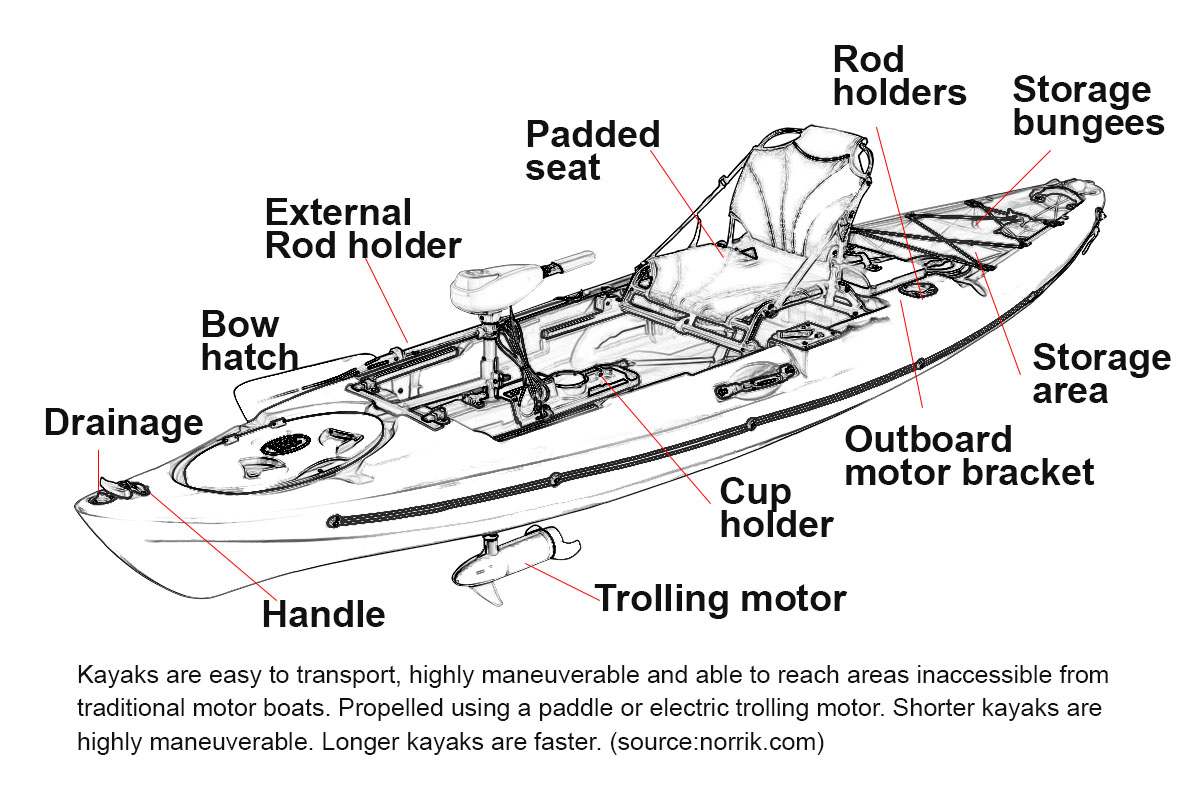
There is arguably no better way to get up close and personal with your prey than kayak fishing. Fishing from a kayak can be a bit challenging, but it’s 100% fun. Kayaks are easy to transport, highly maneuverable and can reach fishing spots inaccessible from shore or traditional fishing boats. Kayaks are propelled through the water by the strength of the occupant using a paddle. However, in recent years kayaks fitted with electric trolling motors have hit the market.
Fishing kayaks can be anywhere from 8′ to 14′ in length. Shorter kayaks are easier to maneuver. Larger kayak can be propelled faster through the water. If you plan on traveling long distances to reach fishing spots, a longer kayak may be advisable. There are a variety of kayaks to choose from. I recommend reviewing the Choosing the Best Fishing Kayak guide to determine which kayak is right for you.
Recently adventurous anglers have even begun using kayaks to target big game fish such as halibut in Alaska!
Length: 8–14 ft
Capacity: 1–2
Range and usage: flats, backcountry, inshore, nearshore
Price: $500–$2,000
Amenties: rod holder, trolling motor, anchoring system
Pros:
- Easy to transport
- Affordable
- Can access narrow, shallow waterways
Cons:
- Require a level of physical fitness
- Can be challenging for anglers
- Limited storage and amenities
Pilothouse
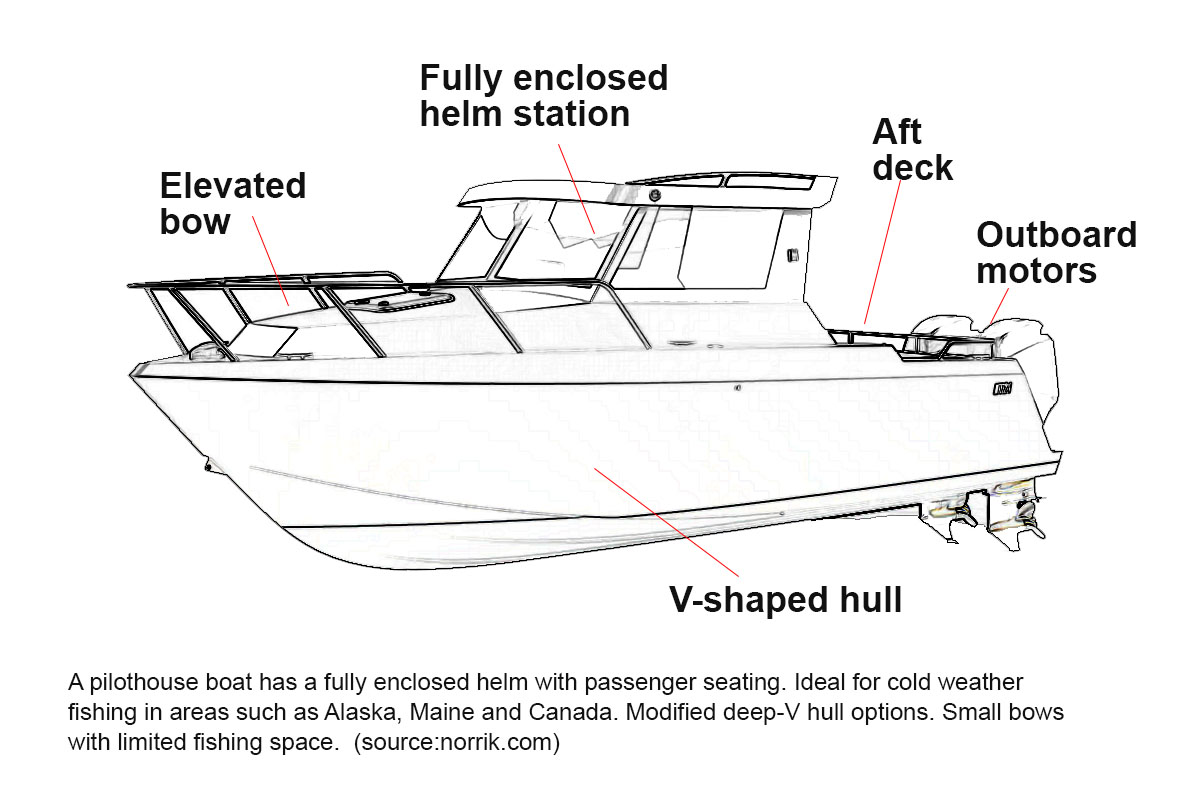
A pilothouse is a fishing boat with a fully enclosed area around the helm and passenger seating. Pilothouse fishing boats are popular in areas such as Alaska and along the coast of Maine and Canada where cold, wet weather is a major factor. Unlike Cuddy Cabins where the cabin is fit with creature comforts for eating, sleeping and cleaning, a pilothouse is only intended to keep the wind out of your face and water off your head.
One of the downsides of smaller pilothouse boats is that the enclosed area takes up a lot of room where anglers could be fishing. On a pilothouse fishing is often restricted to the bow and stern. That being said, I’d much rather fish from a pilothouse in Alaska on a cold, wet day than stuck on an open bow center console freezing my tailend off.
Smaller pilothouse boats are constructed with aluminum. Larger boats are also constructed using a mixture of wood and resin. Hull design is usually V or deep-V with the later preferable for deep-sea fishing in rough waters. A newer version of the pilot house called a “downeast” has a modified deep-V hull designed to cut through waves instead of going over them. If you’re going to be regulary fishing in rough waters, this is the best pilothouse boat model.
The pilothouse boat can have outboard or inboard models. Getting into a used pilothouse will run you about $15,000 for an older model. Plan on spending more for a newer model. While larger pilothouse boats can exceed a 100′ in length, most recreational models are between 20 and 35 feet in length.
Length: 20–35 ft
Capacity: 4–7
Range and usage: nearshore, offshore
Price: $20,000–$1,000,000+
Amenities: inboard motor, rod holders, navigational electronics, live bait tank, proper head, berth
Pros:
- Enclose area for weather protection
- Limited plumbing
- Entry models are affordable
Cons:
- Can get hot inside the enclosed area without a/c
- The enclosed area takes up a lot of fishing space
- Tend to be front heavy causing a bumpy ride
Pontoon Boat
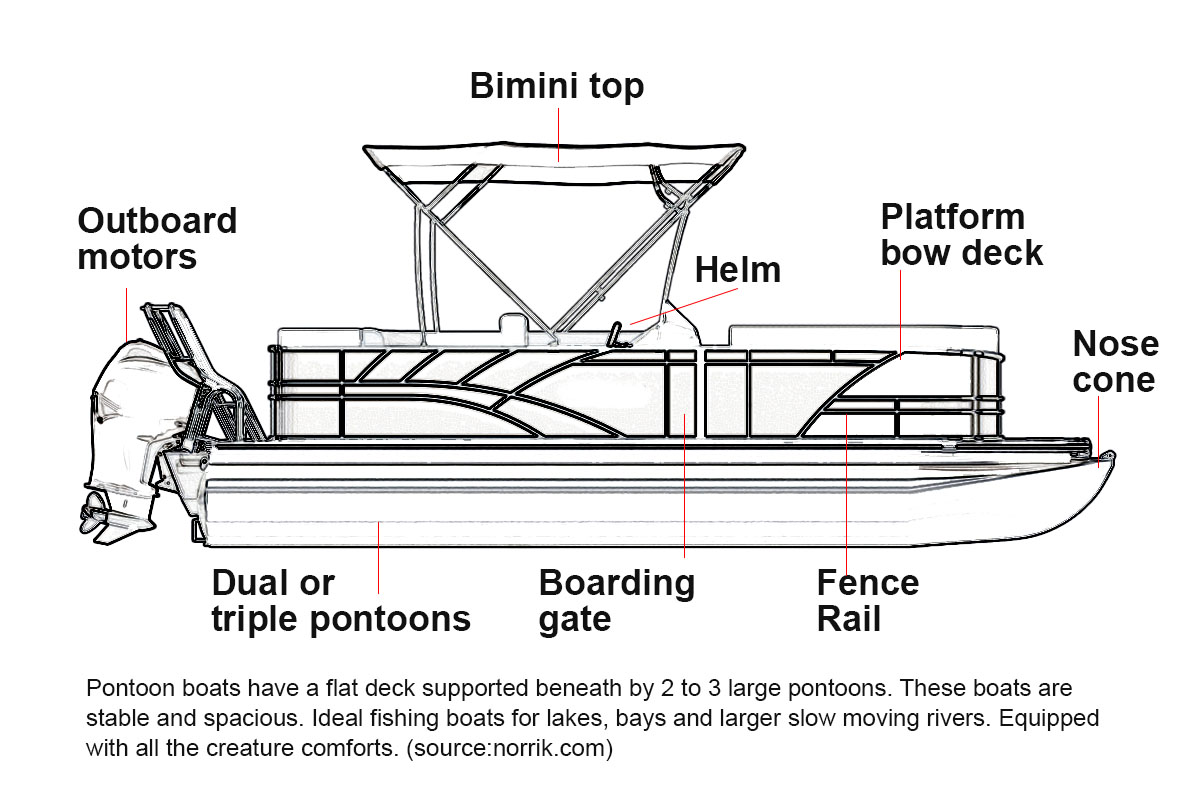
Pontoon boats are the lazy man’s fishing boat. They’re equiped with just about everything you’d find in your living room including sofa and lounge chair. They’re flat, long and a lot of fun–especially if you’re with a group. Due to their smaller engine size they don’t have much get up and go, but there’s no better place to relax and enjoy some down time on the water.
Smaller boats will have two pontoons where larger boats will have three pontoons. Due to their unique design and structure, pontoon boats are very stable. In addition to stability, the flat deck and open floor plan make them good fishing boats for lakes, rivers and bays. I’ve rented pontoon boats several times just to take the family out on the lake and I must say they’re fun boats.
Pontoon boats come in various lengths and sizes. Smaller versions start at about 18 feet and go up to about 30 feet in length. Pontoon boats are priced anywhere from $15,000 for up to $300,000+, although most upper-end recreational models are well under $100,000.
Length: 18–30 ft
Capacity: 6+
Range and usage: lakes, inshore, nearshore
Price: $15,000–$170,000
Amenities: livewells, storage, rod holders
Pros:
- Perfect for family and elderly
- Very stable
- Comfortable (seating, shade, storage, etc.)
Cons:
- Not a traditional fishing boat
- They’re slow moving
- Not designed for offshore excursions
Power Catamaran
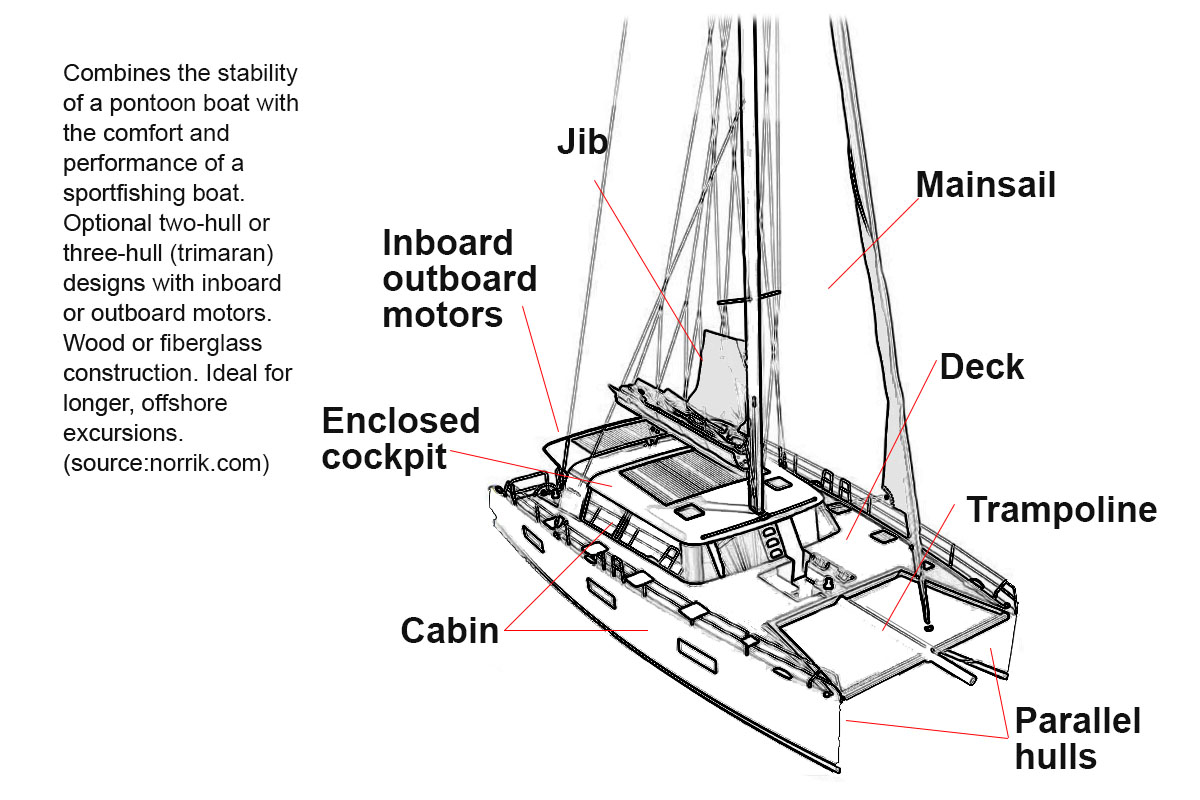
A power catamaran (aka multihill cruiser) combines the stability of a pontoon boat with the all the comfort and convenience of a sportfishing boat. However, unlike a pontoon boat, the catamaran cuts swiftly and smoothly through the water. Catamarans can be either two-hulled or three-hulled, in which case they’re called a trimaran. Catamarans are constructed of fiberglass or a wood-polyester combination. Wood catamarans are typically lighter and stronger than catamarans made of fiberglass. Most power catamarans come with a cockpit, console or cabin.
Smaller power catamarans may have one or two outboard motors, while larger models will be equiped with powerful inboard motors. In my opinion, the ideal length for a fishing catamaran is about 20 to 25 feet. Anything bigger and it gets difficult to fish off them. A basic, entry-level, 20′ used catamaran costs around $25,000. Top of the line 50′ models cost well into the six figures. From what I have seen, a reliabe, quality catamaran, rigged for offshore fishing, will cost you between $250,000 and $350,000.
Length: 25–50 ft
Capacity: 6–30
Range and usage: nearshore, offshore, inshore
Price: $30,000–$6,000,000+
Amenties: cabin, cockpit, navigational electronics, live bait tank, toilet, outriggers, downriggers, rod holders, kitchen, sleeping accomodations (optional)
Pros:
- Very stable on the water
- Wide, roomy, flat deck
- Relatively fast
- More fuel efficient than mono-hull vessels
Cons:
- Larger catamarans are difficult to fish from
Runabout
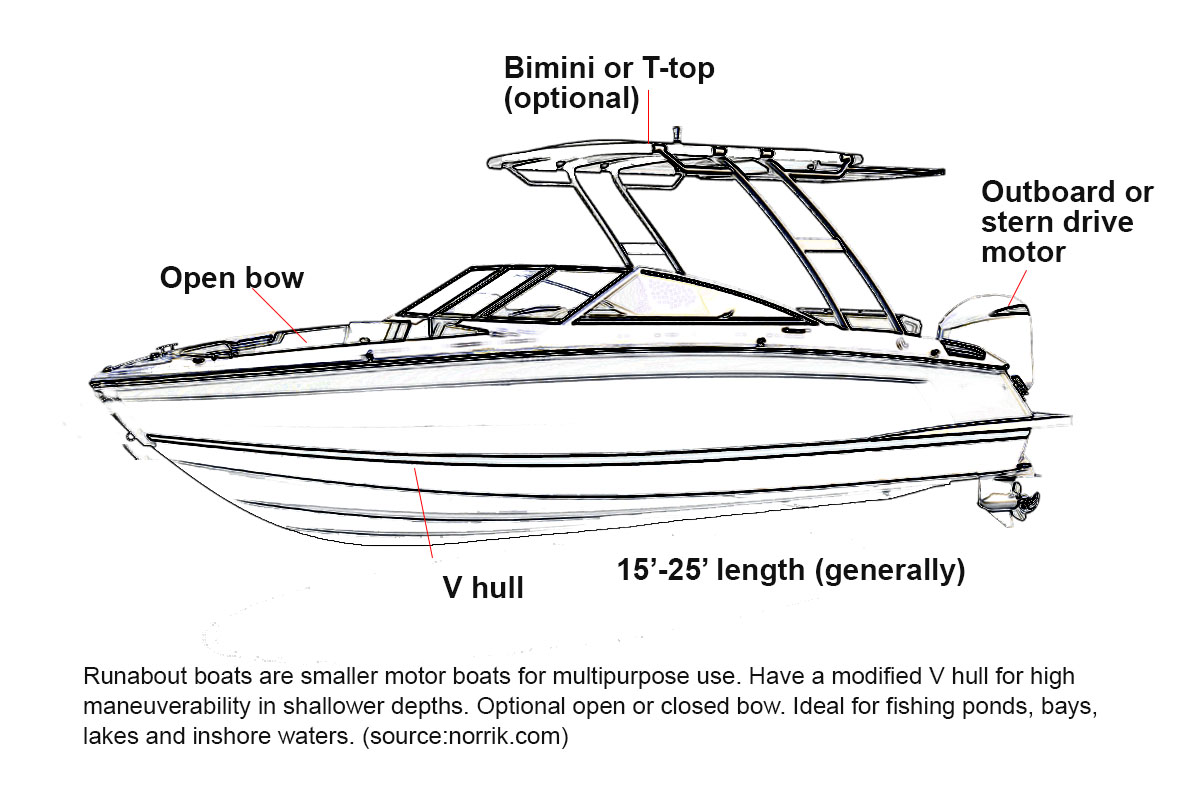
A runabout is a sleek, versatile, smaller powerboat designed to support multiple activities. They can come with an outboard or inboard motor and are typically made of fiberglass. Their modified V hull provides them a sleek look and gives them a shallower water depth. Runabouts can be either open or closed bow. Runabouts with a cuddy cabin are ideal of longer excursions when you want to sleep over or get out of the elements. If you’re looking for more than just a fishing boat, a runabout is a good option.
Older model used runabouts are priced around $5,000 to $10,000. Newer, well-equiped models can cost more than $300,000. I would expect to be able to pick up a runabout in good condition with all the amenities I would need for about $20,000 to $30,000 sligtly used.
Length: 14–25 ft
Capacity: 4–6
Range and usage: inshore, lakes, ponds bays
Price: $5,000–$350,000
Amenities: rod holders, storage
Pros:
- Versatile (fishing, waterskiing, tubing)
- Affordable
Cons:
- Low occupant capacity
- Seating takes away from fishing area
- Not designed for rough water or sea fishing
Walkaround Boat
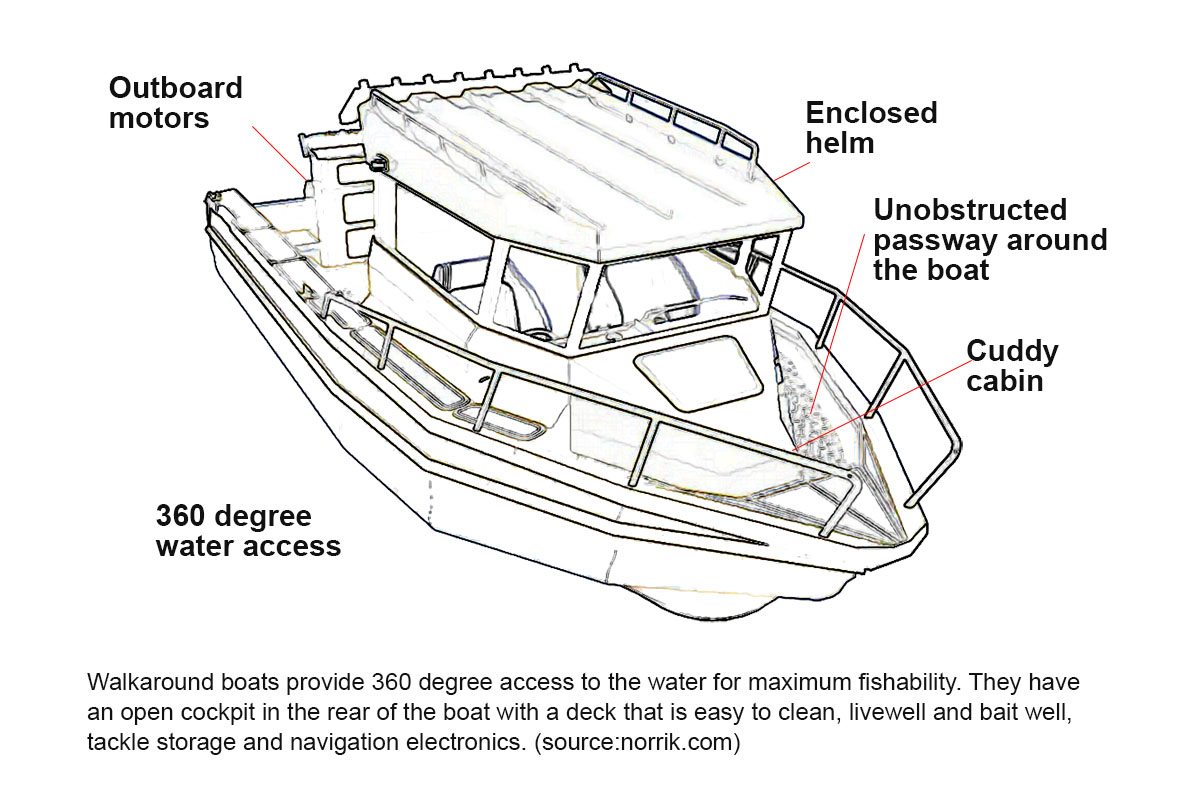
The best way I can describe a walkaround boat is center console meets cuddy cabin. The walkaround boat typically provides 360 degree fishing access around the entire perimeter of the boat as well as a small cabin at the front of the boat. The walkaround is a versatile fishing vessel that provide optimal comfort and fishing access, at a reasonable price. This boat can be used for nearshore and offshore freshwater and saltwater fishing, and is ideal for a full day of fishing and cruising on the open water.
Walkarounds are constructed with fiberglass and come in a variety of designs, the most common being modified-V or deep-V hull. These boats can be anywhere from 15 to over 50 feet in length. The majority of walkarounds are going to be between 20ft and 30ft. You can get into an older model walkround for under $10,000, but like most fishing boats the skys the limit. Larger, newer model walkarounds, with all the perks, can cost over $1,000,000.
Length: 20–30 ft+
Capacity: 4–7
Range and usage: nearshore, offshore, saltwater fishing, freshwater fishing (large lakes and bays)
Price: $9,000–$1,000,000+
Amenities: livewell and baitwell, navigation electronics, rod holders, tackle storage
Pros:
- Versatile for many fishing situations
- Provide comfort and safety during inclement weather
- Offers cabin (bed and sink optional)
Cons:
- Doesn’t always provide complete 360 deck access
- Cabin does not have all the amenities of larger boats


